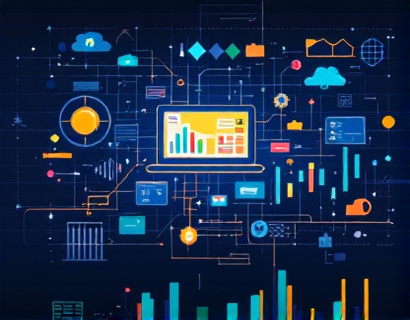Unlocking Business Potential: Cutting-Edge Tech for Enhanced Efficiency and Digital Growth
In today's fast-paced digital landscape, businesses must leverage advanced technologies to stay competitive and thrive. The integration of cutting-edge tech solutions can significantly enhance operational efficiency and drive digital growth. This article explores tailored digital strategies that streamline operations and elevate user experience, providing professionals with the insights needed to optimize their processes and strengthen their digital presence.
The journey towards digital transformation begins with a clear understanding of the current state of business operations. Many organizations still rely on traditional methods that are not only time-consuming but also prone to errors. By embracing modern technologies, businesses can automate repetitive tasks, reduce human error, and free up valuable resources for more strategic activities. The first step is to conduct a thorough assessment of existing processes to identify areas that can benefit from technological advancements.
Automation and Robotics Process Automation (RPA)
One of the most impactful technologies for enhancing efficiency is automation, particularly through Robotics Process Automation (RPA). RPA involves the use of software robots to perform routine and repetitive tasks, mimicking human actions but at a much faster and more accurate rate. These bots can handle a wide range of tasks, from data entry and report generation to customer service interactions and financial processing.
Implementing RPA can lead to significant cost savings and increased productivity. For instance, tasks that previously required multiple hours of manual effort can now be completed in minutes. This not only reduces operational costs but also minimizes the risk of errors, ensuring higher data integrity. Moreover, employees can focus on higher-value activities that require human creativity and critical thinking, leading to improved job satisfaction and better overall performance.
Artificial Intelligence and Machine Learning
Artificial Intelligence (AI) and Machine Learning (ML) are revolutionizing the way businesses operate. These technologies enable organizations to analyze vast amounts of data quickly and extract meaningful insights. AI-driven analytics can predict customer behavior, optimize supply chains, and enhance marketing strategies, providing a competitive edge in the market.
For example, AI-powered chatbots can provide 24/7 customer support, handling inquiries and resolving issues in real-time. This not only improves customer satisfaction but also reduces the workload on human support teams. Additionally, ML algorithms can analyze customer data to personalize experiences, increasing engagement and loyalty. By leveraging AI and ML, businesses can make data-driven decisions that drive growth and innovation.
Cloud Computing
Cloud computing has become an essential component of modern business operations. By moving infrastructure and applications to the cloud, companies can achieve greater flexibility, scalability, and cost efficiency. Cloud services offer on-demand resources that can be scaled up or down based on business needs, eliminating the need for expensive hardware investments and maintenance.
Moreover, cloud platforms provide robust security features and disaster recovery options, ensuring that business data is protected against potential threats. Collaboration tools hosted in the cloud facilitate seamless communication and project management, enabling teams to work together efficiently regardless of their physical location. This is particularly beneficial for remote and hybrid work environments, where traditional on-premises solutions fall short.
Cybersecurity Enhancements
As businesses increasingly adopt digital technologies, cybersecurity becomes a critical concern. Protecting sensitive data and maintaining customer trust are paramount. Advanced cybersecurity solutions, such as artificial intelligence-driven threat detection and blockchain technology, offer enhanced security measures. AI can identify and respond to threats in real-time, while blockchain ensures data integrity and transparency.
Implementing a comprehensive cybersecurity strategy is essential for any business looking to safeguard its digital assets. This includes regular security audits, employee training, and the adoption of best practices in data protection. By prioritizing cybersecurity, organizations can mitigate risks and ensure smooth operations in an increasingly connected world.
User Experience (UX) Optimization
Enhancing user experience is crucial for driving digital growth. A well-designed user interface and intuitive navigation can significantly improve customer satisfaction and retention. UX optimization involves understanding user needs and behaviors through research and testing, followed by iterative design improvements.
Tools like heat mapping and user feedback analytics provide valuable insights into how users interact with digital platforms. By identifying pain points and areas for improvement, businesses can create more engaging and user-friendly experiences. For example, simplifying the checkout process on an e-commerce site or streamlining the onboarding process for a software application can lead to higher conversion rates and customer loyalty.
Content Management and Marketing Automation
Effective content management and marketing automation are key to maintaining a strong digital presence. Content management systems (CMS) allow businesses to create, publish, and manage digital content efficiently. When integrated with marketing automation tools, these systems can schedule content publication, track performance, and analyze audience engagement.
Marketing automation platforms can automate email campaigns, social media posts, and lead nurturing processes, ensuring consistent and targeted communication with customers. By leveraging data analytics, businesses can refine their marketing strategies, focusing on high-performing content and channels. This not only improves ROI but also builds a stronger connection with the target audience.
Internet of Things (IoT)
The Internet of Things (IoT) is transforming various industries by connecting devices and systems to collect and exchange data. For businesses, IoT can provide real-time insights into operations, from manufacturing processes to supply chain management. Smart sensors and connected devices can monitor equipment performance, predict maintenance needs, and optimize resource usage.
In the retail sector, IoT-enabled smart shelves can track inventory levels and trigger automatic reordering, reducing stockouts and overstock situations. In the healthcare industry, IoT devices can monitor patient vitals remotely, enabling timely interventions and improving patient outcomes. By embracing IoT, businesses can achieve greater operational efficiency and innovation.
Conclusion
Unlocking business potential in the digital age requires a strategic approach to technology adoption. By implementing advanced solutions such as automation, AI, cloud computing, and IoT, businesses can streamline operations, enhance user experience, and drive growth. These technologies not only improve efficiency but also provide valuable insights that inform strategic decision-making. As the digital landscape continues to evolve, staying ahead with cutting-edge tech solutions will be essential for long-term success.











































